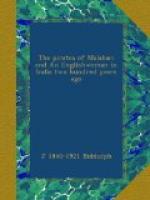[1] The squadron under Barnet, which was sent out
in 1744, on the
declaration of war with France.
CHAPTER X
TWENTY-SIX YEARS OF CONFLICT
The case of Mr. Curgenven—Death of Conajee Angria—Quarrels of his sons—Portuguese intervention—Sumbhajee Angria—Political changes—Disaster to Bombay and Bengal galleys—The Ockham beats off Angria’s fleet—The Coolees—Loss of the Derby—Mahrattas expel Portuguese from Salsette—Captain Inchbird—Mannajee Angria gives trouble—Dutch squadron repulsed from Gheriah—Gallant action of the Harrington—Sumbhajee attacks Colaba—English assist Mannajee—Loss of the Antelope—Death of Sumbhajee Angria—Toolajee Angria—Capture of the Anson—Toolajee takes the Restoration—Power of Toolajee—Lisle’s squadron—Building of the Protector and Guardian.
As an instance of the miseries to which men were exposed by Angria’s piracies, may be mentioned the case of Mr. Curgenven, a private merchant of Madras. Being bound on a trading voyage to China, he sailed from Surat in August, 1720, in the Charlotte. Before he could get clear of the coast, he was captured by Angria’s fleet and carried into Gheriah. There he remained for nearly ten years, during the whole of which time he was made to wear fetters and work as a slave. In spite of the letters he was able to send to Bombay, nothing appears to have been done to procure his liberty. At last, on payment of a ransom, he was set free, and joined his wife in England. But the fetters he had worn so long had injured one of his legs, and amputation was necessary. As he was recovering from the operation, an artery burst, and he died on the spot.
With Boone’s departure from India the attacks on the Angrian strongholds came to an end. They were henceforth regarded as impregnable, and Boone’s successors contented themselves with checking the Angrian power at sea.
In June, 1729, Conajee Angria died. He left two legitimate sons, Sakhajee and Sumbhajee; three illegitimate sons, Toolajee, Mannajee, and Yessajee. Sakhajee established himself at Colaba, while Sumbhajee Angria remained at Severndroog, to carry on the predatory policy of their father. In March, 1734, Sakhajee died, and Mannajee and Yessajee were sent to hold Colaba for Sumbhajee. Before long, Mannajee quarrelled with Sumbhajee and Yessajee, and fled to Chaul. The Portuguese espoused his quarrel, and furnished him with a force against Colaba, which was taken; Mannajee gallantly leading the assault, sword in hand. He at once imprisoned Yessajee, and put out his eyes. As soon as the Portuguese force was withdrawn, Sumbhajee attacked Colaba. Mannajee invoked the aid of the Peishwa, who compelled Sumbhajee to raise the siege, and received the Angrian forts of Koolta and Rajmachee in return, while Mannajee proclaimed his allegiance




